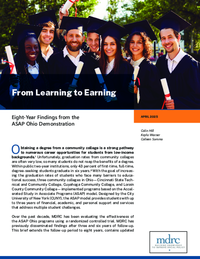From Learning to Earning
Eight-Year Findings from the ASAP Ohio Demonstration

Obtaining a degree from a community college is a strong pathway to numerous career opportunities for students from low-income backgrounds. Unfortunately, graduation rates from community colleges are often very low, so many students do not reap the benefits of a degree. With the goal of increasing graduation rates, three community colleges in Ohio—Cincinnati State Technical and Community College, Cuyahoga Community College, and Lorain County Community College—implemented programs based on the Accelerated Study in Associate Programs (ASAP) model. Designed by the City University of New York, this model provides students with up to three years of financial, academic, and personal support and services that address multiple student challenges.
Over the past decade, MDRC has been evaluating the effectiveness of the ASAP Ohio programs using a randomized controlled trial and has disseminated findings after three and six years of follow-up data collection. This brief extends the follow-up period to eight years, contains updated academic and labor market findings, and examines whether the positive impacts that were found after six years have persisted. After eight years, the program continues to have a positive impact on graduation: 46 percent of students in the program group earned a degree compared with 31 percent in the control group, an increase of 15 percentage points. This sustained academic impact continues to result in significant impacts on earnings for the program group, who earned an additional $3,337 more than the control group’s average of $24,596 in Year 8—an increase of 14 percent.







